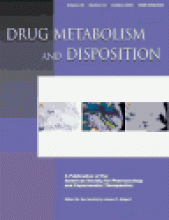Abstract
Liver microsomes, and more recently cryopreserved hepatocytes, are commonly used in the in vitro characterization of the metabolism of new xenobiotics. The flavin-containing monooxygenases (FMO) are a major nonP450 oxidase present in liver microsomes and hepatocytes. Since FMO is known to be thermally labile, and this enzyme may be involved in the metabolic clearance of some drugs, we sought to more completely characterize the metabolic competency of this enzyme in cryopreserved hepatocytes and in liver microsomes preincubated under various conditions using benzydamine as an in vitro and in vivo probe. The metabolism of benzydamine to its major metabolite, theN-oxide, is mediated by FMO3 in humans. We found that the in vitro microsomal t1/2 was 70% longer when incubations were prewarmed at 37°C in the absence of NADPH compared with prewarming in the presence of an NADPH-regenerating system, and N-oxide formation was inhibited >99%. Interestingly, the in vivo clearance predicted from these incubations and from human hepatocytes overpredicted the observed clearance of benzydamine in humans (>10.5 versus 2.4 ml/min/kg). In contrast, rat hepatocytes successfully predicted rat in vivo benzydamine clearance to within ∼30% (>68 versus 48 ml/min/kg). BenzydamineN-oxidation in liver microsomes from all common preclinical species demonstrated heat sensitivity. This information should be considered when extrapolating metabolism data of xenobiotics from these in vitro systems.
Footnotes
-
M.B.F. would like to dedicate this article to Michael R. Rowley (1969–2002).
- Abbreviations used are::
- ADME
- absorption, distribution, metabolism, and excretion
- P450s
- cytochromes P450
- UGT
- UDP-glucuronosyltransferase
- FMO
- flavin-containing monooxygenase
- HPLC
- high-performance liquid chromatography
- DMSO
- dimethylsulfoxide
- MS/MS
- tandem mass spectrometry
- MRM
- multiple reaction monitoring
- CLint
- microsomal intrinsic clearance
- CLint′
- organ intrinsic clearance
- CLb
- blood clearance
- Q
- blood flow
- fublood
- free fraction in blood
- Received March 5, 2002.
- Accepted June 24, 2002.
- The American Society for Pharmacology and Experimental Therapeutics
DMD articles become freely available 12 months after publication, and remain freely available for 5 years.Non-open access articles that fall outside this five year window are available only to institutional subscribers and current ASPET members, or through the article purchase feature at the bottom of the page.
|






